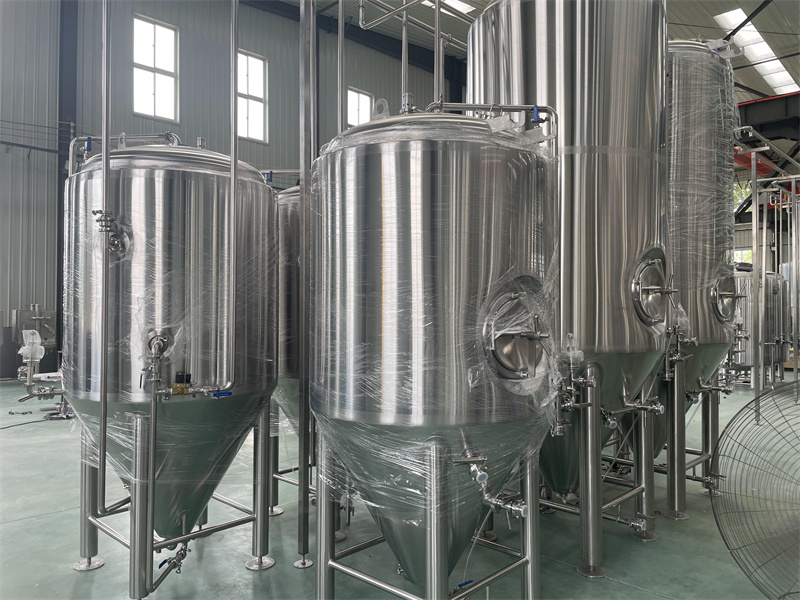A fermenter is a vessel that provides a favorable environment for a specific biochemical process. For some processes, the fermenter is a airtight container with a sophisticated control system. For other simple processes, the fermenter is an open container, and sometimes it is so simple that there is only one opening, which can also be known as an open fermenter.
Type: Double Layer Conical Tank, Single Wall Conical Tank.
Size: 1HL-300HL, 1BBL-300BBL. (Support Customized).
● It should have a tight structure
● Good liquid mixing characteristics
● Good mass transfer phase heat transfer rate
● With supporting and reliable detection, safety components, and control instruments

Beer Fermentation Equipment
1.Construction: Cylinder Cone Bottom Fermentation Tank
The vertical fermenter with a round and simplified conical bottom (conical tank for short) has been used in top- and bottom-fermented beer production. The conical tank can be used for pre-fermentation or post-fermentation alone, and the pre-fermentation and post-fermentation can also be combined in this tank (one-tank method). The advantage of this equipment is that it can shorten the fermentation time, and has flexibility in production, so it can be adapted to the requirements of producing various types of beer.
2.Equipment Features
This kind of equipment is generally placed outdoors. The sterilized fresh wort and yeast enter the tank from the bottom; when the fermentation is the most vigorous, use all the cooling jackets to maintain a suitable fermentation temperature. The refrigerant is ethylene glycol or alcohol solution, and direct evaporation can also be used as the refrigerant; CO2 gas is discharged from the top of the tank. The tank body and tank cover are equipped with manholes, and the tank top is equipped with a pressure gauge, a safety valve and a lens sight glass. The bottom of the tank is equipped with a purified CO2 gas tube. The tank body is equipped with a sampling tube and a thermometer connection. The outside of the equipment is wrapped with a good thermal insulation layer to reduce cooling loss.
3.Advantage
1. The energy consumption is low, the diameter of the pipe used is small, and the production cost can be reduced.
2. For the yeast deposited on the bottom of the cone, the valve at the bottom of the cone can be opened to discharge the yeast out of the tank, and some of the yeast can be reserved for next use.
4.Factors Affecting The Cost Of Fermentation Equipment
Fermentation equipment size, format, operating pressure and required cooling workload. The form of the container refers to the surface area required for its unit volume, expressed in ㎡/100L, which is the main factor affecting the cost.
5.Pressure Resistance Requirements Of Tanks
Consider the recovery of CO2. It is necessary to maintain a certain pressure of CO2 in the tank, so the large tank becomes a pressure-resistant tank, and it is necessary to set up a safety valve.The working pressure of the tank varies according to its different fermentation process. If it is used for both pre-fermentation and beer storage, it should be based on the CO2 content during storage, and the required pressure resistance is higher than that of the tank used for pre-fermentation alone. According to the British design rule Bs5500 (1976): if the working pressure of the large tank is x psi, the tank pressure used in the design is x (1 + 10%). When the pressure reaches the design pressure of the tank, the safety valve should open. The most working pressure of the safety valve should be the design pressure plus 10%.
6.In-Tank Vacuum
The vacuum in the tank is caused by the fermenter turning the tank under closed conditions or performing internal cleaning. The discharge speed of the large fermentation tank is very fast, causing a certain negative pressure. A part of CO2 gas remains in the tank. During cleaning, CO2 may be removed, so a vacuum may also be created. Large vacuum fermentation tanks should be equipped with devices to prevent vacuum. The role of the vacuum safety valve is to allow air to enter the tank to establish a balance of pressure inside and outside the tank. The removal amount of CO2 in the tank can be calculated according to the alkali content of the incoming cleaning solution, and further calculate the amount of air that needs to enter the tank.
7.Convection And Heat Exchange In The Tank
The convection of the fermentation broth in the fermenter depends on the effect of CO2. A gradient of CO2 content is formed throughout the fermentation broth of the conical tank. The fermented broth with a smaller proportion has the lifting power to float. Also, the rising carbon dioxide bubbles during fermentation have a drag force on the surrounding liquid. Due to the gas stirring effect caused by the combination of the drag force and the lifting force, the fermentation broth is circulated and promotes heat exchange in the mixed phase of the broth. Changes in beer temperature during cooling operations also cause convective circulation of the fermentation broth of the tank.
Get A Turnkey Solution For Craft Breweries
If you are ready to open a craft brewery, you can contact us. Our engineers will provide you with a list of craft brewery equipment and related prices. Of course, we can also provide you with professional turnkey brewery solutions, allowing you more time to focus on brewing delicious beer.
Post time: May-22-2023

